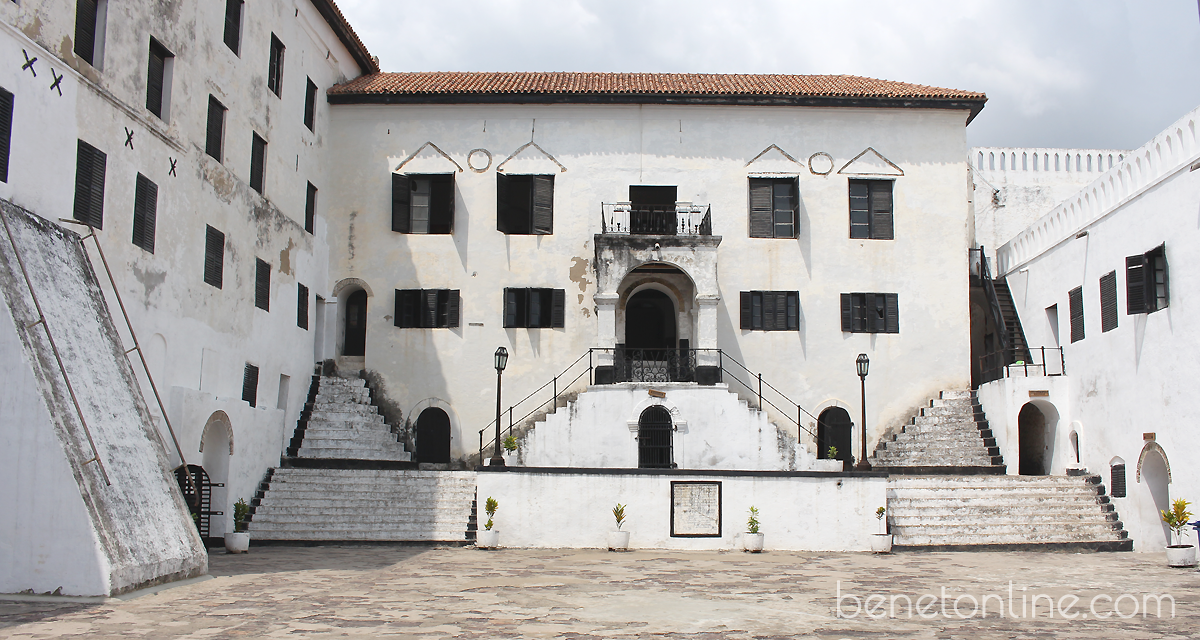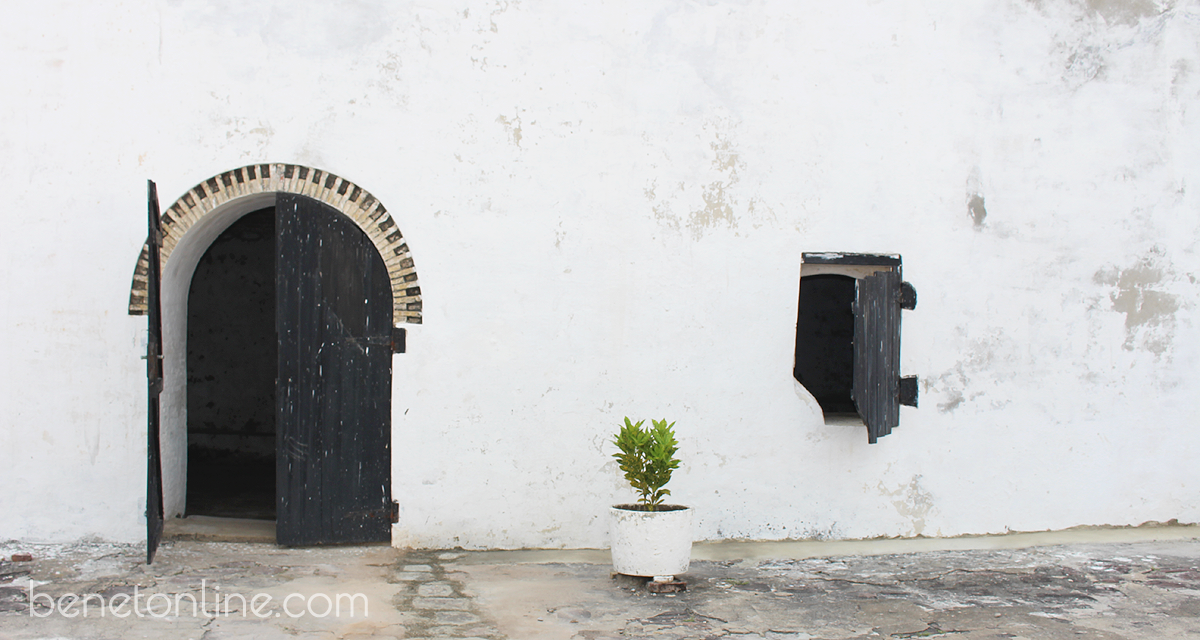Disclaimer: To parents and all readers; this post contains historical facts that may offend your sensibilities and may not be appropriate for young readers. My goal is to share the truth, and to honor the memory of those who fell victim to the Atlantic Slave Trade. If you prefer not to know the plight of those who passed through “The Door of No Return”, then read no further.
The sun was shining, with a slight breeze in the air. It was September 2013 and I found myself sitting in class on the first day of ‘History of the Modern World Since 1550’ – an elective course that fit well with my schedule. Little did I realize on that bright, autumn day, that soon I would buy airline tickets to travel to one of the most historically significant places in modern history; the coast of West Africa. Nor did I realize how much this history course would prepare me for my travels to the countries of Togo and Ghana (countries central to the European colonization of Africa and the Atlantic Slave Trade). Learning the history of Africa was essential for understanding the complexity of this region of the world.
Up until WWI, Togo was a German colony, and then later a French colony. Ghana was colonized by Britain, and was the first country in the entire African continent to gain independence. Signs of European colonization are evident everywhere. It has shaped their culture, economy and way of life (not always for the better) and to this day, the Ghanaians speak English and the Togolese speak French.
There’s a story though, that drew me in- impossible to dismiss or ignore: the story of the Atlantic Slave Trade; a dark chapter of world history whose tale starts on the coast of West Africa…
Elmina Castle – situated on the shores of the Gulf of Guinea is a building full of ironic contrast. The castle’s towering, bright-white walls are dotted with windows overlooking a scene of tropical beauty: sandy beaches, palm trees leaning over the water, and foaming waves crashing on the rocks. In the distance are fishing boats, with men rowing aggressively – off to pull in their nets, always in a race against the tide. The ocean breeze feels refreshing in the hot, hot sun. The sounds of the busy village and squawking birds fill the air. This castle is beautiful, but it’s walls contain heart-wrenching truths.
Above image: Today, the fishermen build boats right on the beach for use on the open seas.
As we waited for the tour to start, we spent time in the center of the castle – there’s a large open area, surrounded by castle walls, with the clear blue sky as the ceiling. A small building is in the middle of this area. The building currently is a museum with images and facts about the former enslaved inhabitants. It has served a variety of purposes, from being a Portugese church to being the ‘market’ where the slaves were bartered. I sat, waiting in the shade, admiring the minimalist beauty of a few plants arranged along the wall, curious about what I would learn.
Above image: A view from inside the castle walls.
The tour guide was very good; he conveyed so many facts and bits of information that it was nearly impossible to keep up. He didn’t mince words, and told the story with brutal honesty. I will try to do the same; as Maya Angelou said:
“For Africa to me… is more than a glamorous fact. It is a historical truth. No man can know where he is going unless he knows exactly where he has been and exactly how he arrived at his present place.”
-Maya Angelou
A bit of basic background information; the castle is 532 years old, and was built in 1482 by the Portuguese, as a fort to protect their gold trade. It was the first trading post built along the western coast of Africa, and is the oldest building in Africa (south of the Sahara desert). Nearly 200 years after it was constructed, it was seized by the Dutch, and used as a holding place for slaves that had been captured and were held in dungeons, waiting to board ships to the Americas. In the 1800’s, it came under British ownership – the Brits didn’t use Elmina castle to house slaves (they used a different castle, further down shore).
Each year, nearly 30,000 slaves passed through Elmina Castle alone. During the entire Atlantic Slave trade, 12,000 million African people were sold into slavery – and thus, these slave castles dot the shores of West Africa. While in Accra, Ghana, we drove by another former slave castle. This particular one served as the Presidential palace after Ghana gained independence, and has been adapted to government office space.
Elmina castle held about 1,000 captives at full capacity; typically 600 males and 400 females. Some of the captives were young children; the girl children were held with the female captives, and the boys with the male captives. Before arriving at the castle, entire families would be captured in their villages by African ‘slave catchers’ from coastal tribes. Other times they became enslaved as a result of tribal wars; either way, once captured, the slaves were forced to walk in chains, with little food or water to get to the castle. Sometimes they had to walk for hundreds of miles to reach Elmina. Just prior to arriving, the captives were given a ‘last supper’, where they were provided with a decent meal and plenty of water. They were bathed, their hair was shaved, and their skin oiled. This was done to give them a healthy appearance before arriving, where they would be exchanged for textiles and horses.
After reaching the castle, the slaves were held in dungeons for up to a couple of months (although, typically it was a shorter period of time); waiting for a ship to arrive that would carry them to the Americas. The dungeons are in the ‘basement’ floor of the castle; they are dark, and damp. The people held in them were cramped and chained together. They were scarcely given enough room to sit – lying down wasn’t an option.
Above: entrance to the male slave dungeon.
The female dungeons were especially unpleasant. Similar to the men, the women were not allowed to wash or maintain any sense of hygiene; they were forced to defecate where they sat or stood. However, as all women know – we have to deal with menstrual cycles; and for those female slaves, staying tidy was not an option. As a result of centuries of impacted filth and human excrement, in some parts of the castle, the floor is now several inches higher than it was when originally built.
Above: Inside the female slave dungeon. The original floor is still intact. I apologize for the lack of clarity in the picture, it was difficult with poor lighting and while being distracted by the tour.
Illness and disease were rampant. Outbreaks of malaria and yellow fever were common. Sometimes captives vomited as a result of the smell of their dungeons. Many of the slaves died from living in the unsanitary conditions. The castle guards recognized how poor the air quality was in the female dungeon, so they installed a small vent, that was designed to bring ‘fresh’ air from the ‘magazine room’, where all the ammunition was stored. Instead of bringing fresh air, the vent did the opposite. It allowed toxic gun powder to pour into the female dungeon, only worsening the air quality.
There is a staircase that leads to a balcony overlooking the women’s dungeons, which was part of the governor’s chambers. He would look over the balcony, and ask that all the women were paraded out of the dungeon so he could choose a concubine. Once a woman was chosen, she would be washed and cleaned by the soldiers and was given a meal. She would then be marched up the narrow staircase to the governor’s quarters.
Left: stairway from female dungeon to the Governor’s quarters. Right: Balcony where the Governor would look down.
The tour guide went on to tell us about the occasional women who rebelled. As I heard this, a small part of me rejoiced that any of these women still were able to cling to their sense of dignity, and that they were strong and brave enough to fight their horrible plight. Another part of me cringed inwardly, knowing that those women surely must have suffered for their bravery. And suffer they did; they were chained to an iron ankle ball that was in blazing, full sun. Sometimes for days, they would be forced to stand and lift cannon balls from the ground (as a pointless, but difficult activity), and were given such little food and water that they nearly died.
Above: The ball where rebellious women were chained.
After touring the dungeons, the guide brought us through a narrow hall that led away from the dungeons. The hall ended in a small room, with a small door… the infamous “Door of No Return”. The captives were led through this door only once… to ships that were waiting. It was the last time many of them saw their families or stepped foot on African soil. This door seared an image in my mind, that I’ll never forget.
Above: The “Door of No Return”
We continued our tour through the castle; the second and third floors of the castle are well ventilated, with windows overlooking the beautiful ocean scene. These floors were reserved for the Governor and housed luxury suites for the European colonists. The rooms are big and airy, with balconies and walkways leading from one room to another.
At the end of our tour, the guide brought us back to the lower floor of the castle, to a small cell, with an ominous skull painted over the entrance. As we stepped into the room, he closed the door made of iron bars and remained silent for a moment. I noticed flower arrangements in the corners; similar to what we would bring to a gravesite as a memorial. The guide explained that this room was reserved for any African men who were uncooperative or rebellious. They were kept in this cell, without food or water, until death. Not one person who was sentenced to this cell, survived.
My heart ached. I blinked back tears. I stood, silent. Thinking of all those people who had once stood in the very place I now stood.
There is a plaque next to the condemned dungeon that reads:
“In Everlasting Memory of the anguish of our ancestors. May those who died rest in peace. May those who return find their roots. May humanity never again perpetrate such injustice against humanity. We, the living, vow to uphold this.”
Above left: Our tour guide- the photo of him was taken by Raimo, one of the guys we were traveling with. Right: Windows from the upper floors of the castle have beautiful views.
Above left: Inside one of the cells. Right: The cell where condemned male slaves were kept until death.
Above left: slave brand, Right: chains used to secure captives.
Above: inside another of the slave dungeons.
Above: I’m in full ‘tourist mode’, trying to take it all in.



















